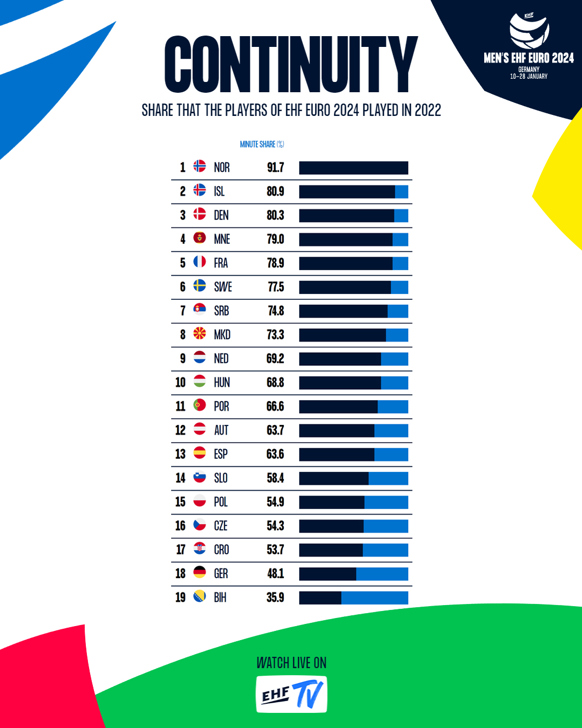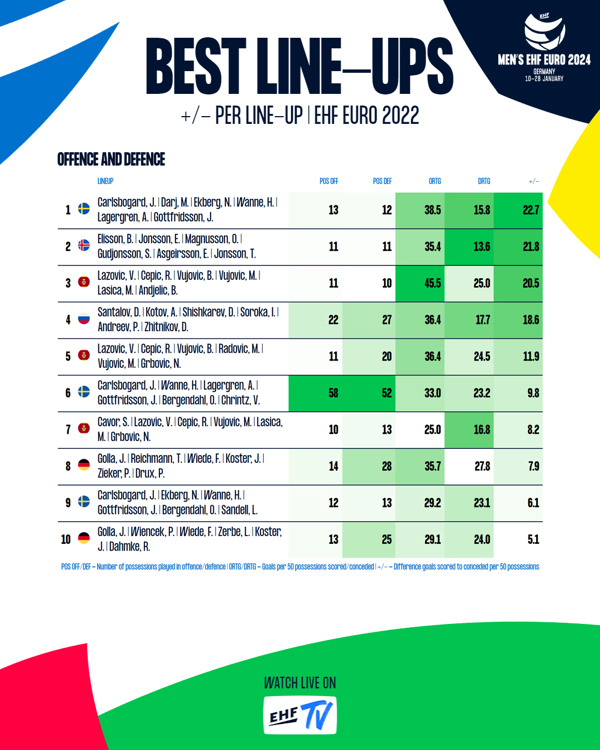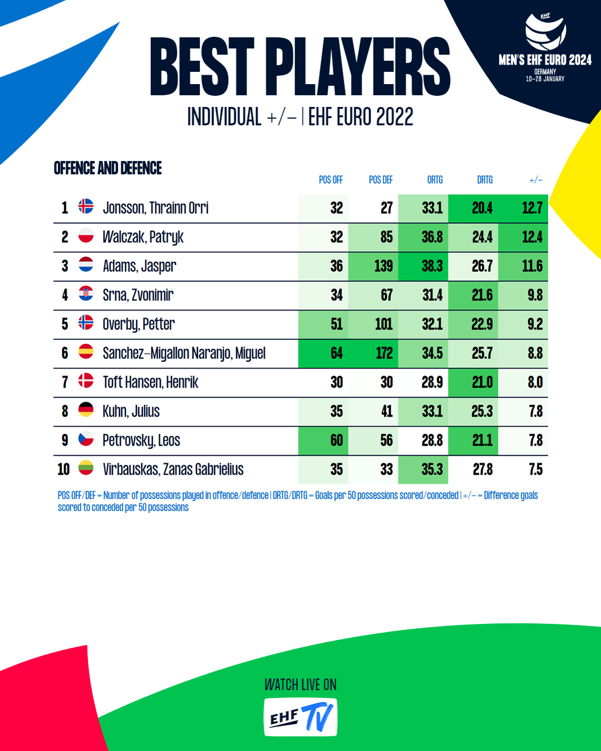An important building block of success in sports is to be well-rehearsed. As the players in national teams spend most of the year with their club teams, that part is not so easy for their coaches. Therefore, continuity plays a big role.
Looking back at EHF EURO 2022, at the time this article was written 216 players that played in Hungary and Slovakia are in the squads of EHF EURO 2024. They played 69.2 per cent of all the minutes that the 19 teams that qualified for both tournaments played two years ago.
But there are clear differences between the teams. Norway has the most continuity, because the players on their team for EHF EURO 2024 played 2.704 minutes out of the 2.948 minutes that the whole team played in 2022, or 91.7 per cent. In addition, seven of their players play together at club level in Kolstad.

Bosnia and Herzegovina, on the other hand, bring the most fresh faces to the tournament. Players who featured in 2022 account for just 35.9 per cent of the minutes played two years ago this time around. At 48.1 per cent, the hosts Germany have the second fewest, but still significantly more than Bosnia.
The plus/minus statistic in handball
Being well-rehearsed, however, of course does not just mean being on the same squad but actually playing together. Discounting goalkeepers, the combination of players that played the most together at EHF EURO 2022 were again the Norwegians. Sander Sagosen, Sebastian Barthold, Kristian Bjørnsen, Magnus Gullerud, Christian O’Sullivan and Harald Reinkind played almost 75 minutes together (38.2 in offence, 36.7 in defence).
While all six of them are in the squad for Norway this year as well, for the second most played line-up at the last EHF EURO that is not the case. The Swedish combination of Jonathan Carlsbogård, Hampus Wanne, Albin Lagergren, Jim Gottfridsson, Oscar Bergendahl and Valter Chrintz played 72.2 minutes together in 2022 (35.3 in offence, 36.9 in defence). But Valter Chrintz is not in the squad this year.
After these two line-ups the third most played line-up was Poland’s Michal Daszek, Michal Olejniczak, Sicko Szymon, Kamil Syprzak, Arkadiusz Moryto and Przemyslaw Krajewski, who played just 36.8 minutes together, less than half of Sweden’s most used squad on the field. However, contrary to Norway’s and Sweden’s most used line-up they played almost all their time together in offence. This is also the case with almost all the next most frequently used line-ups.
Analysis based on line-ups is very common in other sports. The so called plus/minus statistic originated in ice hockey but is also used in basketball. Plus/minus tries to measure the impact of a line-up or field player by the difference between the number of goals their team scored and conceded when they are in the game.
Of course, the concept cannot be used directly in handball. Because of changes between attack and defence, line-ups and players who only play in attack would have a clear advantage over players who play in both or the defence specialists. For example, Iceland’s Aron Pálmarsson, Bjarki Mar Elisson, Gisli Kristjansson, Ýmir Gíslason, Ómar Ingi Magnusson and Sigvaldi Bjørn Gudjonsson had the best raw plus/minus with 31 more goals scored than conceded.
This line-up shows the two biggest problems that raw plus/minus has in handball. Firstly, it is a line-up that was almost exclusively used in attack, as Gisli Kristjansson only played defence when a substitution was impossible.
Secondly, Magnusson and Elisson, Iceland’s two main seven-metre penalty takers, are in this line-up. So, for example, if one of them was on the bench when the penalty shot was received but then substituted in, the goal would count for the line-up with them and not the one that received the penalty shot.
An easy adjustment for the second problem is not taking into account goals from penalty shots, but instead awarding received seven-metres with 0.789 goals, which is the average amount a penalty shot attempt was converted at EHF EURO 2022.
Another adjustment for the second problem is to look at offence and defence separately, because there are just not enough line-ups that played a large enough number of possessions on both ends of the field. When the raw number of goals are then adjusted to the same number of possessions the plus/minus can for example come from the difference to the average of the tournament or the whole team.
The best line-ups
Applying this, the best offensive lineups (at least 10 possessions played) at EHF EURO 2022 were surprisingly, under both approaches, the Montenegrin combination of Vuk Lazovic, Radojica Cepic, Branko Vujovic, Milos Vujovic, Marko Lasica and Bozo Andjelic. They scored +20.4 in comparison to their team overall average of 25.1 goals per 50 possessions and had an outstanding +18.0 compared to the tournament average of 27.5.
Eleven possessions is of course not a very meaningful sample size, and many things could have easily influenced this, but maybe Montenegro should have relied more on this line-up to be more successful. As all but Lasica are again in their squad, this combination could be important for them again this time.
Standing out amongst the 10 most efficient line-ups are Iceland’s aforementioned six. They were by far the most used amongst the most efficient groups and all six of them are on the roster for this year’s EURO as well. So, look out for them being the key for success for the Scandinavians again.

Defensively, Portugal’s Gilberto Duarte, Victor Iturriza, Diogo Branquinho, Alexandre Cavalcanti, Antonio Areia and Fabío Magãlhaes were the most efficient in comparison to the average of their own team. When they were on the field, they conceded 14.0 goals less per 50 possessions than their team tournament average of 29.0. Compared to the tournament average Iceland’s squad of Bjarki Mar Elisson, Elvar Jónsson, Ómar Ingi Magnusson, Sigvaldi Bjørn Gudjonsson, Elvar Ásgeirsson and Thràinn Orri Jònsson fared the best with +13.9.
However, 10 and 11 possessions are not very big sample sizes, and we probably will not see these line-ups at EHF EURO 2024 as several of these players are not on the rosters.
The best heavily used defensive formation was France’s Yanis Lenne, Dika Mem, Nikola Karabatic, Ludovic Fabregas, Hugo Descat and Karl Konan who had +9.9 and +8.6 in 34 possessions. They are all back again this year.

For lineups that played in offence and defence, however, an adjusted plus/minus is of course also possible. 27 combinations played at least 10 possessions in offence and in defence in 2022. Amongst them, the most efficient were Sweden’s Jonathan Carlsbogard, Max Darj, Niclas Ekberg, Hampus Wanne, Albin Lagergren and Jim Gottfridsson with 22.7 more goals scored than conceded.
Unsurprisingly, the reigning European champions also have the most efficient line-up amongst the heavily used groups with Jonathan Carlsbogard, Hampus Wanne, Albin Lagergren, Jim Gottfridsson, Oscar Bergendahl and Valter Chrintz (+9.8). With all except right wings Ekberg and Chrintz back, Sweden will be again a force to be reckoned with if they utilise these line-ups frequently.
Mixed significance for individual players
These plus/minus analyses are not only possible for line-ups, but also on an individual level. Adrian Figueras had the best raw plus/minus in 2022 with +80 and the best with adjustment for penalty shots with +82.2. Again, you can see the main problem of the raw plus/minus statistics in handball, as Figueras, like all players who have very good numbers here, played much more in attack than defence.
The best individual adjusted offensive numbers in comparison to the average of EHF EURO 2022 amongst players that played at least 25 possessions was Poland’s Patryk Walczak with +10.9. When Jasper Adams was on the field the Netherlands scored 12.3 goals more per 50 possessions, which was the best in this category. Neither will have the opportunity to confirm their numbers this year.

On defence, Lasse Andersson had the best plus/minus to the tournament average, as when he was on the field Denmark conceded 7.3 goals per 50 possessions less than the average team in 2022. When Bartlomiej Bis played, Poland conceded a tournament-leading 7.8 less. While Andersson did not make the squad, Bis is in.
The best net plus/minus amongst players that played at least 25 possessions on both sides was Iceland’s Thràinn Orri Jònsson with +13.1 per 50 possessions. In 2022 he was called up while the tournament was ongoing due to the team losing players because of Covid-19. This year he did not make the roster.

While the plus/minus has many advantages as it can account for all the hidden contributions a player makes, these numbers demonstrate that it has a lot of problems, especially on an individual level. The fact that some of the players with the best statistics of the last EHF EURO are not in the squad this year shows that the significance is limited.
Firstly, there is the high variability, as the sample size of possessions played is not that high and it is impossible to see if the good or bad numbers are more influenced by the player himself or his teammates. Secondly, not just the teammates but also the opponents are not always on the same level; for example many minutes played against bad opponents can heavily improve the plus/minus numbers. Also in defence, of course, the goalkeeper should not be excluded in the analysis.
In basketball and ice hockey there are more advanced methods that account for these problems and in handball they will follow soon. But besides that, plus/minus on a line-up level is not perfect but more meaningful. And it has shown which combinations of players could shine again and be the key in EHF EURO 2024.
More from data analyst Julian Rux can be found at Handballytics.de. There you can read his latest articles, in which he analyses all kinds of handball topics from new, data-based perspectives. You can also find him on Instagram, Facebook and X.
Photo © Uros Hocevar / kolektiff











